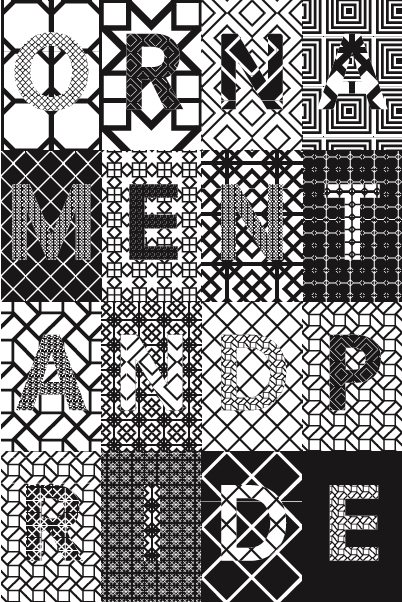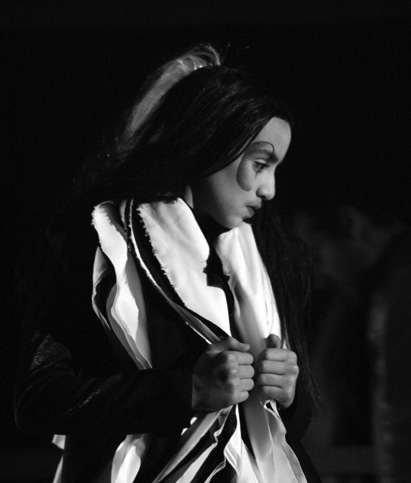EXHIBITION
Originally conceived for S.M.A.K., Gent, 2006-2009
In March 2006, I was appointed guest curator of the S.M.A.K. in Gent, Belgium. For a three-year period I acted as an ‘international ambassador’ of the museum, my principal task being the development and realisation of an international exhibition. With this in mind, I developed Ornament and Pride, a project about ornament, craftsmanship and critical thinking, which was supposed to start in 2008. Due to financial difficulties of the S.M.A.K., the project was never realized.
If you are interested in collaborating on this exhibition project, please contact me.
Ornament and Pride
Ornament and Pride is an exhibition project that intends to radiate visual pleasure. It brings together an important group of international artists whose work demonstrates a strong interest in crafts and decorative elements. Point of departure is the belief that this interest is not simply a return to formalism, but that behind the aesthetic and tactile qualities of the work of these artists there is a strong engagement with the world. The exhibition is an invitation to discover the creative and critical potentials of their ‘decorative’ and ‘ornamental’ imagery, and to explore the underlying cultural, philosophical and/or spiritual concerns of these artists.
Artists (subject to change)
Persijn Broersen & Margit Lukács (1974/73, The Netherlands)
Hassan Darsi (1960, Morocco)
Vidya Gastaldon (1974, France)
Dylan Graham (1972, New Zealand)
Corey McCorkle (1969, United States)
Zoë Mendelson (1976, Great Britain)
Younès Rahmoun (1975, Morocco)
Yehudit Sasportas (1969, Israel)
Lucy Skaer (1975, Great Britain)
Joanne Tatham & Tom O’Sullivan (1971/67, Great Britain)
Jennifer Tee (1973, The Netherlands)
Motoi Yamamoto (1966, Japan)
and graphic designers:
Richard Niessen & Esther de Vries (1972/74, The Netherlands)
Concept
In 1908 Adolf Loos wrote his famous essay ‘Ornament und Verbrechen’ (translated in English as ‘Ornament and Crime’). In this essay Loos equates the use of ornamentation with cultural decline, moral turpitude and even crime. Loos’s condemnation of ornamentation laid the ideological foundations of Modernism; his views continue to have a profound influence on Western culture.
In 2008, precisely one hundred years later, the S.M.A.K. will organize an exhibition project entitled ‘Ornament and Pride’. This project aims to raise a debate about the existing preconceptions of ‘ornament’, ‘decoration’ and ‘craftsmanship’, and to restore to them some dignity.
In recent times the subject of ‘decoration’ has again become the focus of interest, both in the visual arts, architecture, design and fashion. Ornamentation, patterns and arabesques are springing up everywhere. The exhibition project ‘Ornament and Pride’, however, does not treat the subject as a fashion phenomenon or a design trend that will be quickly superseded by another buzzing word in a day or two. Neither does it seek to place the theme within a broad historical and cultural framework. ‘Ornament and Pride’ takes as its express point of departure a meaningful internal reflection into the subject, and a qualitative selection of artists. It brings together a group of promising artists from the Western world and from outside the Western world, for whom the decorative is not merely a question of form or style, but a means of establishing a debate about social, philosophical and spiritual matters.
Questions and themes
The exhibition ‘Ornament and Pride’ is intended as a feast for the eye, with subtle architectural murals (Richard Wright), manufactured objects and installations (Yehudit Sasportas, Jennifer Tee), folkloric motifs (Joanne Tatham & Tom O’Sullivan) and exuberant patterns (Persijn Broersen & Margit Lukàcs), delicate line drawings (Zoë Mendelson), historically inspired decorative cut-outs (Dylan Graham), spiritual pieces (Motoi Yamamoto, Younès Rahmoun) and much more.
At the same time the exhibition invites visitors to reflect on a number of important questions. What does the revival of interest in the ‘decorative’ and ‘craftsmanship’ mean? What are the issues raised by the work of these artists? Is there a critique of the current fixation of the art world on politically engaged discursive practices here? Is there a plea for a language of art that is richer, more complex, mysterious and less rigid than that of the dominant Modernism? Or is, besides a formal critique, also a criticism of Western modernity in general? Could it be a form of protest against the current rational and individualistic society, a counterpoise to the prevailing neo-liberal economics and politics, and the ‘excess of capitalism’? And what does this return to decorative traditions say about the relationship between Western and non-Western cultures?
Traveling project
‘Ornament and Pride’ is a project that will resonate on various levels and in many different ways. The starting point is a two-week project in Morocco with a group of around fifteen international artists. The decision to initiate the project in Morocco is influenced by two factors: on the one hand the presence of a rich decorative tradition, and on the other the emergence of a local contemporary art scene, still young but unmistakably flourishing. Following the research trip, the artists will create new works, which will be presented in a major exhibition in the S.M.A.K. in Ghent. Subsequently this exhibition will travel to partner institutions abroad.
Download the ‘Dossier Ornament & Pride (april 2007)‘









